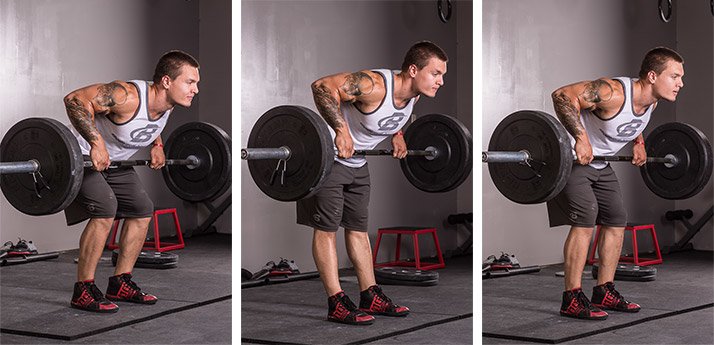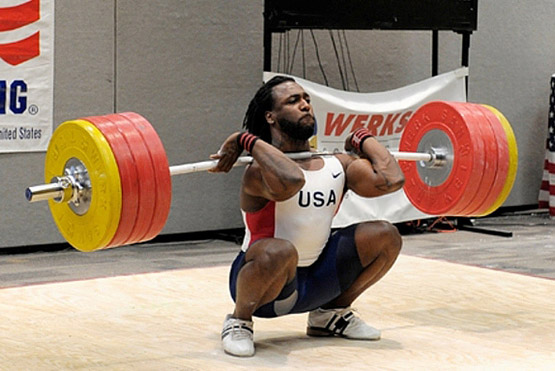The squat is often considered the king of weightlifting exercises. It takes an enormous toll out of your body, piles muscles onto your legs, and builds an amazing amount of mental toughness. It tests more than just your quadriceps, it’s almost a whole body exercise. If you’re looking for some advice on how to squat more weight, you’re definitely in the right place.

It makes sense to want to pile on the plates, since the more resistance you face the greater the benefits will be. If you’re a powerlifter, or just want to get the most out of this exercise at all times, read on and we’ll be able to show you how to add more weight and get even more out of this incredible exercise. So let’s get right to it, and help you kick your body into overdrive.
Contents
What You’ll Need
You’ll only need a couple of things to start adding weight to your squats.
- The Bar
- The Plates
- A Squat Rack or Power Rack
- Determination
- Ab Wheel
It’s not a tall order to get, and if you’re here you probably already have all or most of these. A rack is absolutely necessary, once you’ve been squatting regularly there’s no other way to get that much weight on your back.
Determination is key, without it, you won’t be able to get through the process. Squats are hard, and if you’re doing it right you’ll be panting at the end of each set and pretty wobbly after the last one. Then you’ll need to do it again in a few days.
If you’ve got the equipment and the mental fortitude necessary, you’re ready to get started on your way to massive thighs and an increase in full body power you’ve never dreamed of.
1) Get Your Form Down
Squats are a no-nonsense exercise, and cheating risks some major injury. Follow the above video and you should be well on your way to good form. One of the biggest considerations is not to round your lower back, this can lead to injury and also hurt the amount you can lift.
Rounding your lower back is the biggest mistake and the most dangerous one. This can lead to you doing part of a good morning at the top of the lift with an excessive amount of weight. Under 200lbs or so, and you might not even notice, but you’ll definitely start to feel the damage once you’re squatting an appreciable weight.
The second most common error is not going deep enough. While it might feel good to lift more weight, the only person you’re fooling is yourself. Use a weight where you can get through the full range of motion, and you’ll get a lot more benefit out of the exercise.
2) Strengthen Your Core

Squats will strengthen your core quite a bit, but if you want to push your numbers to new levels it’s a good idea to take the extra time to work on your abdominals and lower back as well. The extra stability added will allow you to break personal records in no time at all.
Since the function of the core is primarily stabilizing the torso on the way down and up, exercises which emphasize using the core as a whole unit are the best. Possibly the best of these is using an ab wheel, far from being a gimmick these devices will challenge your core more than any other exercise.
Sit-ups and other endurance exercises for the abdominals aren’t what you’re looking for here. If you can’t get your hands on an ab wheel, hanging leg raises are a good alternative as well as the various plank exercises. They’re simply inferior to rolling out on an ab wheel though so consider the investment.
[thrive_text_block color=”green” headline=””]Protip: In addition to training the core, you can also immediately increase your lift with the following method: at the top of the squat take a deep breath and tighten your entire core. Hold this breath as you go down and don’t release it until you’re on the way up while keeping your core tight. [/thrive_text_block]3) Tighten Your Upper Back

Source: Bodybuilding.com
You’ll need to strengthen your upper back to push some serious weight, especially as the number of 45lb plates on each side increases. By doing so you can create a tight “shelf” where you hold the weight, and avoid any additional soreness. While squats are primarily thought of as a lower body exercise, merely holding the massive amounts of weight you’ll be pressing can induce a lot of stress on your back’s muscles.
One thing that a lot of lifters don’t think about is where the bar is and how it can affect their upper back. You want your elbows under the bar, and keep in mind a narrower grip can make it easier to keep your upper back tight but is dependent on your shoulder mobility. Keep it tight through your whole set, perhaps allowing yourself a brief rest at the very top of the motion.
Really, your whole upper body should be tight. Chest flexed, core tightened, and lats engaged as you pull down on the bar. It’s your upper back that’s sure to mess you up more than any other part of your torso, though.
You can supplement your routine with different barbell rows to keep things in high gear, and good mornings can be quite an impressive addition as well. Be careful with the latter, though, overdoing it can lead to some serious injuries.
It’s really all about practice, and the more time you spend working on keeping your upper back tight the better off you’ll be.
4) Diversify Your Squats

Source: robertsontrainingsystems.com
If your weak point during the squat is your quads and hips, you’ll want to consider adding front squats to your routine. While back squats certainly do work your quads, the emphasis is actually primarily on your posterior chain of muscles. Front squats can help you sort out this inequality.
If you perform the Olympic style, with your elbows up and hands to your shoulders, you’ll find it also helps with your shoulder flexibility which can help you get a narrower grip on your normal squats.
If you’re just concerned about your legs, the bodybuilder style front squat with the bar on your chest and arms crossed over the bar will still make a great supplemental exercise.
It’s still important to use proper form, but, especially for the Olympic style, it’s much harder to cheat on a front squat. Go as deep as you can, preferably butt-to-heels, and start with low weight or even just the barbell to get a feel for the motion if you’re not already familiar with it.
Front squats are a great, functional exercise by themselves and adding them to your routine can help to skyrocket your normal squats to whole new levels.
[thrive_text_block color=”green” headline=””]Protip: If you have lower back or knee issues that are causing you a lot of trouble when you perform back squats, consider shifting the emphasis in your training to front squats. They’re a lot friendlier on the spine and joints than their more highly-touted brother.[/thrive_text_block]5) Get Flexible

Source: Ning.com
One thing that most people neglect when they’re squatting is their flexibility. It’s a surprisingly important factor, though, both in getting the weight up and in preventing injury under heavier loads. If you can’t squat comfortably with your hamstrings on your calves while flat-footed, you’re going to need to get some work done.
While front squats can help with this, if you’re particularly stiff it’s time to spend a little bit of extra time each day getting things in order. For your hips, which are often a sticking point in weightlifters, there’s almost no better static stretch than the Kneeling Hip Flexor Stretch. It’s easy to perform, place your rear knee on the floor and stretch out your front leg until it reaches a point where it’s just beginning to stretch. Lean forward slowly, and extend the distance between your legs as your flexibility increases.
If you’re having trouble with keeping your heels on the floor as you come down into a full squat, something you might want to consider is your ankle flexibility. If your ankles are too tight it can affect your flexibility quite a bit. Ankle rotations are a good way to gain this, as well as pronating and supinating the ankle with your hands.
[thrive_text_block color=”green” headline=””]Protip: It’s a good idea to perform these stretches even on your off-days from squats. The increased mobility will make for an impressive increase in your squatting potential more quickly with daily stretching.[/thrive_text_block]6) Pause Reps, Partials, and More
If you’ve got everything else in order, it’s time to focus on the real work that goes into getting this lift as high as possible. There’s a number of techniques used by powerlifters which are sure to increase your squat rapidly. A word of advice, though: if the rest of your squat isn’t in order, you won’t receive much benefit from these advanced techniques.
The first of these is Pause Reps, this is pretty much a normal squat, but when you hit the bottom count off three seconds before rising. This will lessen the effect of your stretch reflex quite a bit, making it harder than a normal repetition where you rise as soon as you hit the desired depth. It’s especially useful if you generally fail the lift at the bottom of the movement, and it can give you more power out of the hole.
The second technique you might want to try is Partial Repetitions, these will involve you only going down a fraction of the amount you normally would. Add them into your routine, especially if your trouble in hitting new personal records is at the top of the squat, right before lockout. You can work with a bit heavier weight than normal, but it’s important to have the rack set properly and have a spotter when you’re doing these.
If you’re using partial repetitions, it’s also important to make sure that you’re doing Full ROM Squats. Powerlifters, in particular, tend to neglect these since they only have to go a little bit past parallel in competition. Really, these should be your primary focus anyways, going all the way down. Some people only go to parallel, however, and it can make a brand new exercise for them
Conclusion
If you’re looking to put on some mass, there’s no better way to do it than with squats. Whether you’re competing, bodybuilding, or just looking for massive, functional strength in your daily life it should be a staple of your program. It takes hard work, dedication, and some knowledge, but if you follow these steps carefully, you’ll soon find your numbers going up. More weight means receiving more benefits from the squat, the King of Exercises.
Did you enjoy this guide? Let us know in the comments.
Leave a Reply
You must be logged in to post a comment.